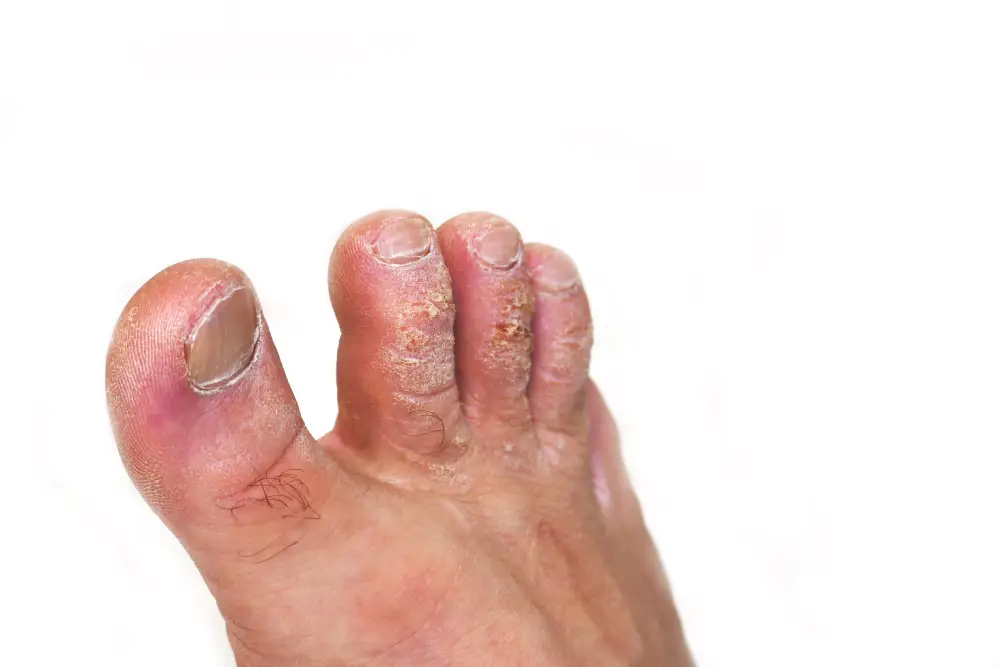Ever caught a whiff of something odd coming from your gym shoes and wondered if it’s more than just sweat? That distinct athlete’s foot smell might be telling you something important—something your nose shouldn’t ignore. But what exactly causes that odor, and could it signal more than just a fungal nuisance? The answer might change how you think about foot care forever.
Healthy feet start here—Book your athlete’s foot treatment with a dermatologist now! ✅🦶

Why Athlete’s Foot Can Cause a Bad Smell
The unpleasant odor linked to athlete’s foot doesn’t come only from the fungal infection—it also results from a complex process involving bacteria and specific environmental conditions. Here’s how this happens:
Initial fungal infection: Athlete’s foot is caused by fungi that usually affect the skin between the toes. These fungi thrive in warm, moist environments, where they begin to break down the skin’s natural protective barrier.
Moisture: Sweaty feet and enclosed shoes create ideal conditions for fungal growth. Constant humidity supports fungal development and encourages bacterial colonization.
Bacterial overgrowth: Once the fungus damages the skin, it leaves openings that allow bacteria to invade. These bacteria feed on dead skin cells, natural oils, and other organic materials.
Bacterial decomposition and acid release: As bacteria break down these materials, they produce waste byproducts in the form of organic acids. These acids are responsible for the strong, unpleasant smell commonly associated with athlete’s foot.
Good hygiene and moisture control help prevent complications linked to athlete’s foot. Noticing unusual foot odor can prompt early action and reduce the chances of the infection worsening or spreading to other areas.
What the Smell Says About the Severity of Your Infection
Foot odor caused by athlete’s foot can be an early sign that the infection is progressing, though it doesn’t always reflect how severe the condition is.
A stronger, more unpleasant smell may point to a secondary bacterial infection, which requires additional treatment. Identifying the difference between fungal and bacterial odors is useful, since the latter might signal a more advanced condition that could require antibiotics.
Key odor indicators:
- Mild smell: Typically linked to the original fungal infection.
- Strong, pungent smell: May suggest a secondary bacterial infection, which can be more serious than the fungal issue.
Infection types and associated odors:
| Fungal infection | Mild, musty, or slightly sour |
| Secondary bacterial infection | Strong, unpleasant, penetrating smell |
Changes in the strength or character of the smell can help determine whether the infection is getting worse. A noticeable increase in odor might signal growing risk and the need to consult a healthcare provider.
Other Common Symptoms That Go With the Odor
Odor isn’t the only sign that can indicate athlete’s foot. This infection often comes with a range of symptoms that affect the skin—and in some cases, the toenails.
Skin Symptoms
The skin may show several visible changes and uncomfortable sensations that get worse without treatment.
Common skin symptoms:
- Cracked, flaky, or peeling skin: Especially between the toes or along the sides of the foot.
- Intense itching: Often worsens right after removing shoes and socks.
- Redness or discoloration: Skin may appear red, inflamed, or take on purplish or grayish tones depending on skin color.
- Burning or stinging: A sensation of heat or irritation is common in affected areas.
- Blisters: Small, fluid-filled blisters may develop in more severe cases.
Nail Changes
The infection can spread to the toenails, causing visible signs of damage.
Common nail changes:
- Thickened nails: Nails may become visibly thicker.
- Color change: Affected nails may turn white or yellow.
Additional Symptoms
Other symptoms can develop as the infection worsens.
Additional signs:
- Pain: Cracks in the skin can cause discomfort, especially when walking or wearing shoes.
Noticing symptoms that go along with odor helps catch the infection early and avoid more serious problems. Watching for skin changes, intense itching, or nail issues can lead to faster and more effective treatment.
How to Get Rid of the Smell and Treat Athlete’s Foot for Good
Clearing up the odor and getting rid of athlete’s foot requires a mix of proper hygiene and antifungal treatment. Wash your feet regularly with warm water and gentle soap, dry them thoroughly—especially between the toes—and apply antifungal products to eliminate the infection. Also, disinfecting your shoes and keeping your feet dry helps stop the fungus from lingering.
Treatment should include antifungal creams, powders, or sprays. Follow product directions and complete the treatment even after symptoms improve to reduce the risk of the infection coming back. Disinfect your footwear with appropriate products and let them air out for at least 24 hours to help eliminate any remaining fungus.
Taking steps to prevent future infections makes a difference. Wear sandals in public showers, avoid sharing personal items like towels or shoes, and keep your feet clean and dry. If symptoms continue or get worse, speak with a doctor or pharmacist to get the right treatment and fully eliminate the infection.
Sources:
- Palos, S. A., Pereira, R. R., & Silva, M. J. (2023). Bacterial Superinfection in Athlete’s Foot: A Critical Role in Disease Progression and Odor Production. International Journal of Dermatology, 62(7), 864-869. DOI.
- Kim, Y. H., Lee, H. W., & Park, D. S. (2024). Comprehensive Review of Fungal and Bacterial Interactions in Athlete’s Foot and Their Clinical Implications. Journal of Clinical Microbiology, 62(1), 42-47. DOI.
